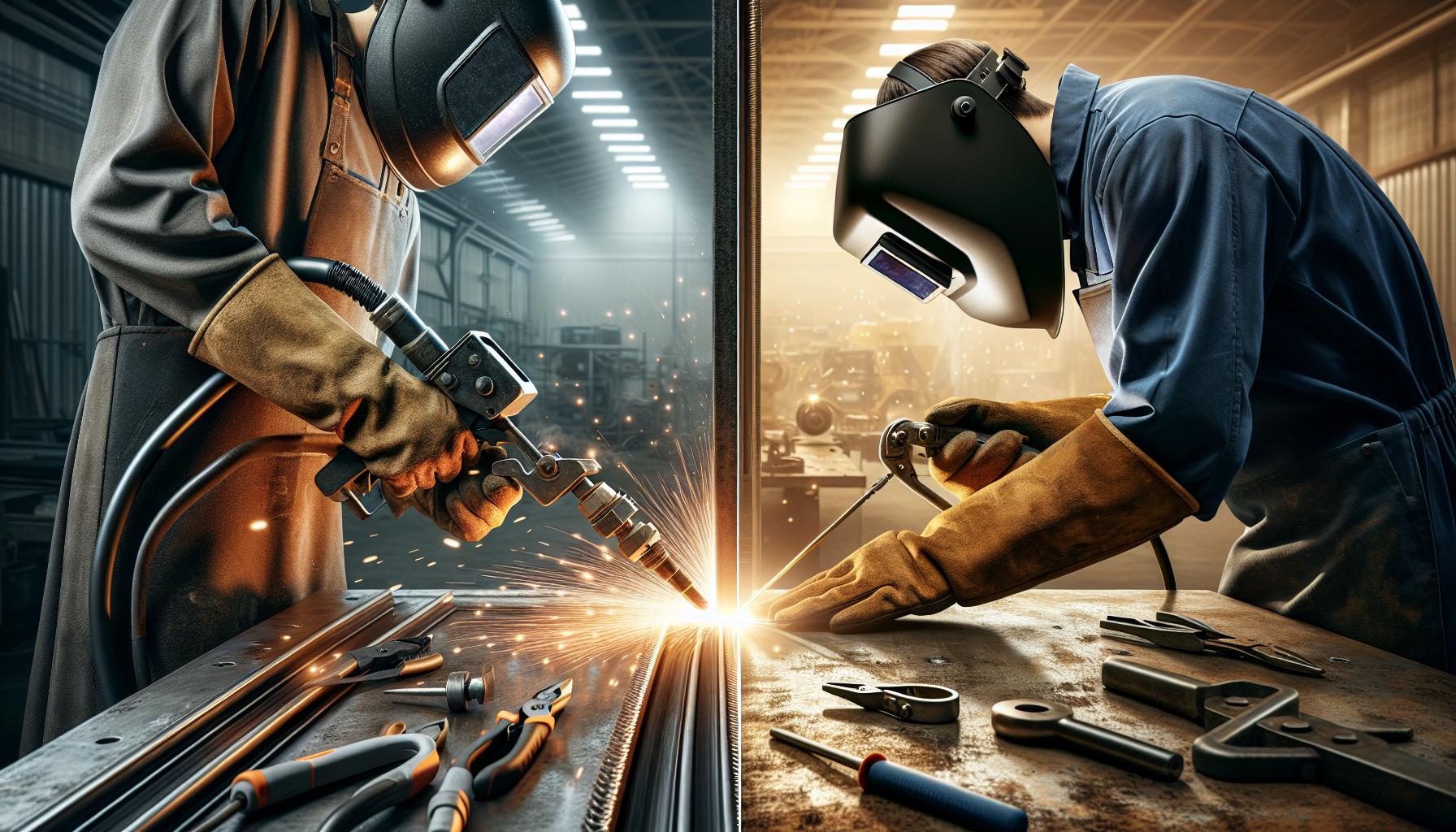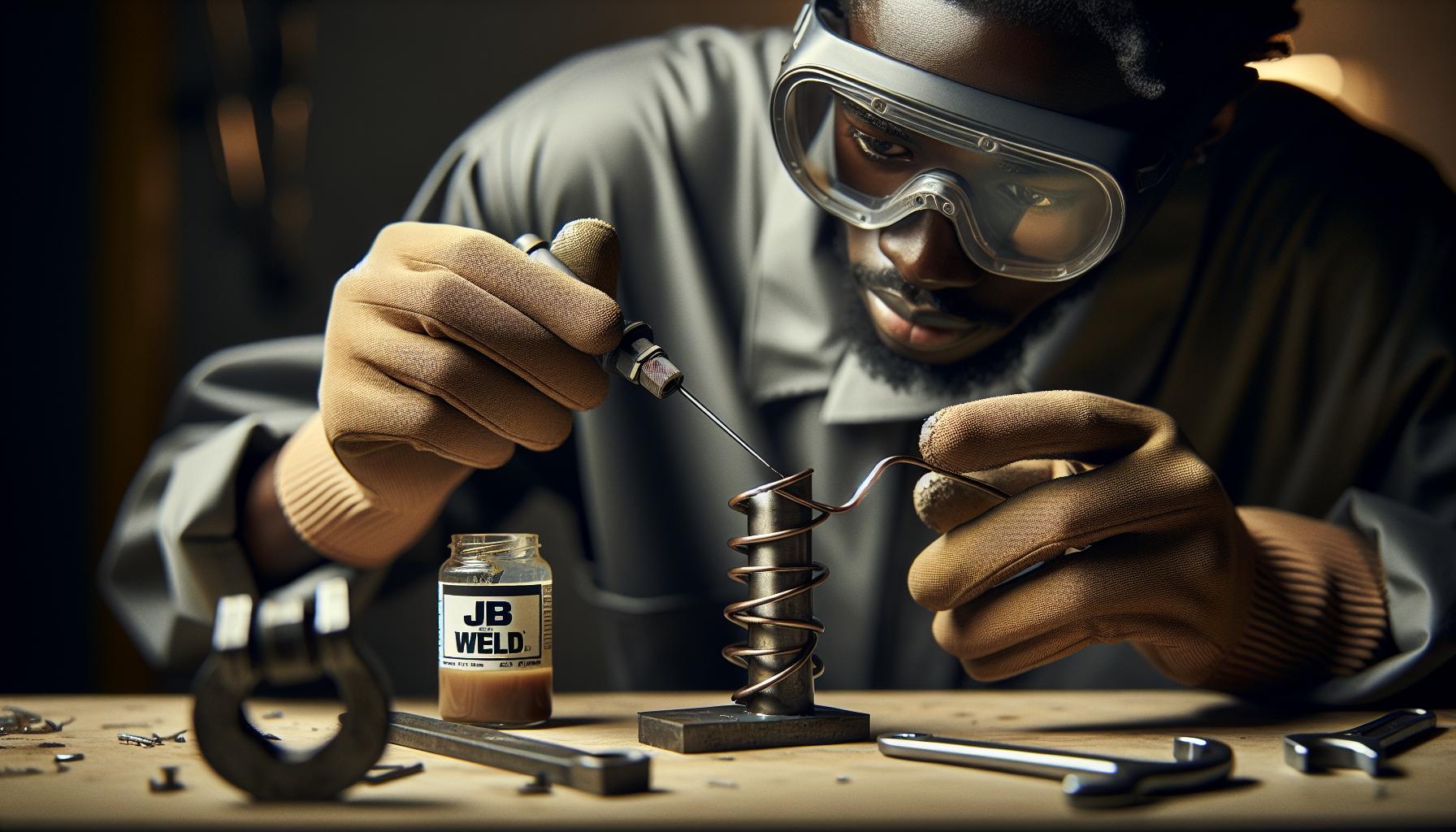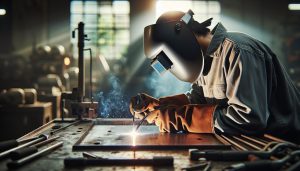Transforming an arc welder into a plasma cutter opens up a world of possibilities for metalworking enthusiasts and professionals alike. Not only can this conversion significantly enhance cutting precision and speed, especially with tougher materials like stainless steel and aluminum, but it also offers a cost-effective solution for those looking to expand their tool arsenal without breaking the bank. Whether you’re a beginner eager to learn the ropes or a seasoned welder seeking to optimize your workflow, this guide will provide essential insights on safety protocols, technical specifications, and step-by-step instructions for a successful conversion. Embarking on this project will not only empower your welding capabilities but also deepen your understanding of plasma cutting technology, making it a valuable addition to your skill set. Keep reading to discover how you can unlock the full potential of your arc welder.
Understanding Plasma Cutters vs. Arc Welders
When delving into the world of metal fabrication, understanding the distinctions between plasma cutters and arc welders is crucial. Both tools serve unique roles, yet their underlying mechanics and applications are distinct. Plasma cutters utilize a high-velocity jet of ionized gas to melt and sever metal with precision. They excel at cutting through thin sheets of electrically conductive materials, such as steel and aluminum, and are favored for their speed and clean cuts. In contrast, arc welders, which operate by creating an electric arc between an electrode and the workpiece, bond metals together by melting them at the joint. This method is more suited for joining metals than cutting them.
When considering a conversion project, recognizing the advantages of each tool type will guide your modifications. For instance, plasma cutting is generally more efficient for intricate designs and thinner materials due to its ability to make finer cuts without requiring secondary finishing, whereas arc welding is advantageous for structurally integral joints. If converting an arc welder into a plasma cutter, it is essential to factor in how the change will affect the thickness of materials you plan to work with.
The decision to utilize one method over the other can simplify your fabrication process. For cutting tasks that demand cleanliness and speed, plasma cutters are superior. However, for welds that require strength and durability, such as in structural applications, arc welders shine. Understanding these differences not only helps in achieving better results in your projects but also ensures that the tools you choose are optimized for your specific needs.
Essential Tools for Your Conversion Project
To successfully convert an arc welder into a plasma cutter, having the right tools is essential. This transition not only enhances your equipment but can also expand your capabilities in metal fabrication. First, you will need a quality arc welder that can deliver the necessary amperage for the conversion. Ideally, a DC inverter welder is preferred due to its versatility and efficiency. Ensure the welder you are using has adjustable output settings, as this will allow you to tailor the power for different cutting tasks.
Next, a plasma cutting torch assembly is crucial. This includes a torch body, various nozzles, and an electrode designed specifically for plasma cutting. Selecting the right torch compatible with your welder can significantly influence the quality of your cuts. Additionally, a cutter’s air supply system should not be overlooked. You’ll need a clean, consistent flow of compressed air or nitrous oxide, as this is the medium that creates the plasma arc necessary for cutting. A high-quality air regulator with a moisture trap will help maintain the purity of the air supply, ensuring optimal performance and longevity of your equipment.
Safety gear also plays a paramount role in the conversion process. Proper personal protective equipment (PPE), such as welding helmets with appropriate filters, safety goggles, gloves, and durable clothing, will protect you from the intense light and heat generated during plasma cutting. It’s also wise to have a fire extinguisher nearby, and ensure your workspace is free of flammable materials to mitigate risks.
Lastly, a workspace equipped with an assortment of hand tools-such as pliers, wire cutters, and wrenches-will aid in the assembly and adjustment of the converted plasma cutter. Depending on the complexity of your conversion, you may also require a multimeter to ensure proper electrical connections and settings. Having these essential tools and equipment on hand will not only streamline the conversion process but also set you up for success in your future plasma cutting projects.
Step-by-Step Guide to Conversion Process
Converting an arc welder into a plasma cutter can significantly enhance your metalworking capabilities, allowing you to achieve cleaner cuts with greater precision. This process, while technical, can be broken down into manageable steps that ensure safety and effectiveness. Before diving in, ensure you have all essential tools at your disposal, including hand tools, a plasma cutting torch assembly, and proper safety gear.
Begin by securely disconnecting your arc welder from its power source to prevent any accidents. Once it’s safe, remove the welding leads from the welder, as these will no longer be used in the plasma configuration. Then, you will attach the plasma cutting torch assembly. This assembly typically consists of a torch body, an electrode, and a nozzle. Following the manufacturer’s guidance, ensure that all components are compatible with your specific welder model. Utilize any included diagrams to assist with assembly, ensuring a snug fit to prevent gas leaks.
Next, you need to set up a suitable air supply system. Using a high-quality air compressor, connect the air supply to the plasma cutter torch. This step is crucial, as a consistent and clean airflow is necessary for creating the plasma arc. Incorporate a moisture trap and regulator to keep the air free of contaminants, which can negatively affect performance. After connection, test the air pressure to ensure it meets the required specifications detailed in your plasma cutter’s manual.
Once the physical conversion is complete, double-check all your connections and settings, making fine adjustments as needed. Reconnect the welder’s power supply and perform a test cut on scrap material, starting with low amperage settings. Monitor the cut quality and adjust the settings accordingly to find the optimal range for your specific cutting tasks. This experiment will not only validate your setup but also familiarize you with the operational nuances of your converted machine.
Finally, it’s vital to perform regular maintenance checks on your new plasma cutter. Clean the torch and replace worn accessories to ensure the longevity and effectiveness of your tool. By following these steps, you’re not only enhancing your welding setup but also acquiring a skill set that is both valuable and versatile in the metal fabrication industry.
Safety Precautions When Converting Equipment
Converting an arc welder into a plasma cutter is a labor-intensive task, but neglecting safety measures can lead to life-threatening accidents. When working with high-voltage equipment and gases, ensuring a safe working environment is paramount. Before commencing any conversion, equip yourself not only with the necessary tools but also with the correct personal protective equipment (PPE). At a minimum, this should include safety goggles, gloves resistant to heat and cuts, and protective clothing to shield against sparks and stray arc flashes.
To start, ensure the workspace is well-ventilated. This is critical because plasma cutting produces potentially harmful fumes. If possible, carry out the conversion in an open area or ensure that your workspace is equipped with adequate ventilation. Additionally, be cautious of your surroundings. Remove any flammable materials and ensure that you have a fire extinguisher nearby. Accidents can happen even with careful preparation, and knowing you have a fire extinguisher readily accessible is a peace of mind that should never be overlooked.
Moreover, follow proper electrical safety procedures. This means completely disconnecting the arc welder from its power source before initiating the conversion. Double-check that all switches are in the “off” position and that the welder is unplugged. Use insulated tools to prevent accidental electrical shorts and ensure that you are not working in damp conditions, as moisture increases the risk of electric shock. Furthermore, if you’re uncertain about the specifications and requirements of your welder, consult the user manual or reach out to a professional for guidance-better safe than sorry.
Ensuring that all connections and components are secure and leak-free is another critical safety aspect. Poor connections can lead to gas leaks, which could result in an explosion if ignited. During the setup, regularly inspect all hoses and fittings for any signs of wear or damage and replace them as necessary. Always remember that safety is not a one-time check but a continuous process throughout the conversion and beyond. Prioritizing safety will not only protect you but will also enhance the overall effectiveness and longevity of your newly converted plasma cutter.
Adjusting Settings for Optimal Plasma Cutting
The ability to adjust settings for optimal plasma cutting can significantly enhance the efficiency and quality of your projects. Plasma cutting relies on a finely controlled arc and airflow, making it essential to fine-tune your setup. The adjustments required depend largely on the material being cut, its thickness, and the type of arc welder you have converted.
Start by carefully selecting the correct amperage setting. Generally, the thicker the material, the higher the amperage required. As a rule of thumb, aim for approximately 1 amp per 0.001 inches of material thickness. This means a 1/4-inch thick steel would typically require about 60 amps for effective cutting. Adjustments to other factors such as voltage may also be necessary, particularly in regards to achieving a clean cut without excessive dross or burn-through.
Air Pressure Settings
Using the right amount of compressed air is equally critical in plasma cutting. Most plasma systems operate optimally at a pressure range of 60 to 100 psi. Insufficient air pressure can lead to poor arc stability and increased cutting time. Test different pressures within this range to find what works best for your specific setup and material. Keeping a pressure gauge readily available will help you make quick adjustments before starting to cut.
Travel Speed
Another vital factor to consider is the travel speed of the cutter. Traveling too quickly may result in an incomplete cut, while moving too slowly can lead to excessive heat build-up, resulting in warpage or unwanted material damage. A good approach is to practice on scrap material to determine the optimal speed for your setup. Adjust your cutting speed based on the results you observe, aiming for a steady pace that allows for clean edges and minimal slag buildup.
Making these adjustments requires both technical understanding and hands-on practice. Keep thorough notes on the settings you use and their effects on your cut quality to streamline the process for future projects. By carefully managing these variables, you’ll not only increase the efficiency of your plasma cutting operations but also improve the overall quality and appearance of your finished work.
Common Issues and Troubleshooting Tips
Common conversion issues can turn an exciting project into a frustrating experience, but knowing how to troubleshoot effectively can save both time and materials. One prevalent problem is inconsistent arc stability, which is often caused by improper air pressure or incorrect nozzle selection. If the cut quality is poor or you’re experiencing significant dross, check your air supply; most plasma cutting systems require air pressure between 60 to 100 psi for optimal performance. You may also want to experiment with different nozzle sizes, as each can affect the arc’s focus and cutting ability based on the material thickness and type.
Another common issue arises from amperage settings. If the cut feels sluggish or is not penetrating, it’s a strong indicator that your amperage is set too low; conversely, if the torch is excessively burning through or warping the material, the amperage may be too high. It’s critical to remember the rule of thumb: approximately 1 amp per 0.001 inches of material thickness. Always keep a scrap piece of the same material close by to test adjustments before cutting your actual workpiece.
Furthermore, inadequate travel speed can lead to additional complications. Should you notice that the plasma cutter is leaving behind excessive slag, the travel speed may be too slow. Practicing on scrap material can help you find the sweet spot between cutting speed and heat accumulation, ensuring a clean and efficient cut.
Lastly, remember that electrical issues might arise during your conversion process. Faulty connections can cause intermittent arc stability or complete power failure. Make sure all wires and connectors are secure, and consider using heat-resistant electrical tape to prevent wear from high temperatures. Regular inspections and maintenance of your components will help preempt these problems and keep your plasma cutter running smoothly.
Maintenance Tips for Your Converted Plasma Cutter
Maintaining a converted plasma cutter is critical to ensuring its longevity and performance. Regular upkeep not only enhances cutting effectiveness but also mitigates potential hazards associated with wear and tear. One of the key aspects of maintenance is to routinely check and replace consumables, such as nozzles and electrodes, which can wear out quickly under the high temperatures and pressures typical of plasma cutting. In fact, a worn nozzle can lead to poor cut quality and increased dross, which may necessitate additional cleanup work.
Equally important is the inspection of air supply components. Ensure that air filters and dryers are clean and functional, as moisture contamination can drastically affect cutting performance. A reliable dry air supply prevents oxidation and helps maintain a stable arc, resulting in cleaner cuts. Regularly drain moisture from air tanks and check hoses for cracks or leaks; any compromised airflow can lead to inconsistent cutting and potential damage to the cutter.
Electrical Connections
Electrical connections should be inspected frequently, as loose or corroded connections can cause erratic performance or even failure during operation. Use a multimeter to check the continuity of cables and ensure that connections are free from rust or debris. Keep a roll of heat-resistant electrical tape on hand to secure and protect any vulnerable wires that may be exposed to high heat during cutting operations.
Another major aspect of maintenance is cleaning the work area and the cutter itself. Soot, dust, and slag can accumulate and pose risks not just for the machine, but for the operator as well. Establish a routine to clean the cutter after use. This includes wiping down the chassis, clearing away any debris from the cutting table, and ensuring that the cooling vents remain unobstructed. These practices help in prolonging the life of both the cutter and the workspace, allowing for a safer and more efficient cutting environment.
Exploring Material Compatibility: Steel and Aluminum
When considering a plasma cutter conversion from an arc welder, understanding the material compatibility of steel and aluminum is crucial. Plasma cutting excels in versatility, making it suitable for a wide range of materials, primarily due to its ability to produce high-quality cuts with minimal distortion. However, different materials require specific considerations to optimize performance and ensure safe handling.
Steel is among the most commonly cut materials with plasma systems. Its durability and structural integrity make it a favorite in industrial applications. When plasma cutting steel, it is important to adjust settings such as amperage and cutting speed based on the thickness of the steel. For instance, thicker materials will require higher amperage to achieve clean cuts without excessive dross formation. Preheating thicker steel also aids in reducing cutting times and improving the quality of the cut. For further optimization, using a water table can help in reducing slag, keep the work area clean, and dissipate heat, minimizing warping of the material.
Aluminum, while also manageable with plasma cutting, presents unique challenges due to its properties. It is lightweight and has a high thermal conductivity, meaning it can absorb heat quickly and may distort if not cut precisely. When cutting aluminum, consider lowering the cutting speed and using a pulse setting to achieve better control over the heat input. This practice prevents excessive melting of the edges and produces a smooth cut surface. Additionally, keeping the cutting area free of contaminants like oil and grease can enhance the quality of the cut and prolong the life of consumables.
Ultimately, successful plasma cutting of steel and aluminum hinges on the careful adjustment of parameters and an understanding of the materials’ behaviors during the cutting process. By mastering these elements, you can achieve optimal results while ensuring safety and efficiency throughout your cutting tasks.
Enhancing Performance with Upgraded Components
To truly elevate the performance of a plasma cutter converted from an arc welder, selecting the right upgraded components is essential. Enhanced components not only improve cutting efficiency and quality but also extend the lifespan of the equipment. Upgrading specific parts can lead to significant advancements in precision, speed, and overall performance, which are crucial for professionals and hobbyists alike.
One critical area to consider upgrading is the plasma cutting torch. An improved torch can provide better heat management and airflow, resulting in cleaner cuts and reduced dross formation. Look for torches designed explicitly for plasma cutting, as they often come with features such as enhanced cooling systems and ergonomic designs that improve handling during prolonged use. Additionally, consider the consumables used, including electrodes and nozzles. Switching to high-quality, compatible components can dramatically affect cut quality and operational efficiency. Regularly replacing these consumables ensures optimal performance while extending the life of your torch.
Another performance-enhancing modification relates to the power supply. Upgrading to a more powerful, consistent, and reliable power source will allow for better amperage control. This change not only enhances the quality of the plasma arc but also allows you to cut through thicker materials with greater ease. Using a high-frequency start technology can also significantly improve start-up reliability and enhance cutting performance.
Incorporating a sophisticated cooling system can also enhance performance, particularly during intensive or prolonged cutting tasks. A dedicated cooling system helps manage the heat generated during the cutting process, preventing overheating and damage to both the plasma cutter and the material being cut. It ensures sustained cutting performance without interruptions, thereby increasing productivity.
Lastly, adjusting the air supply is crucial for optimal plasma cutting. Investing in a high-quality air compressor that delivers dry, clean air at the required pressure will improve the quality of your cuts. Contaminated or insufficient air supply can lead to arc instability and poor cutting performance, negating other upgrades.
By focusing on these upgraded components and systems, you can transform your arc welder conversion into a highly efficient plasma cutting machine, providing you with the tools necessary to tackle a wide variety of materials with precision and ease.
Cost Analysis: Is DIY Conversion Worth It?
Converting an arc welder into a plasma cutter can be an enticing cost-saving option, especially for those who are already adept at welding and looking to expand their capabilities. The potential savings, however, must be weighed against the challenges and costs associated with the conversion process. While new plasma cutting equipment can range from hundreds to thousands of dollars depending on features, a conversion can sometimes be achieved with a limited budget, primarily relying on the existing welder.
The initial costs for a DIY conversion typically include purchasing a plasma cutting torch, a suitable air compressor, and necessary consumables (nozzles, electrodes, etc.). Depending on the quality and specifications you choose, these items can total anywhere from $150 to $500 or more. However, you’ll also need to consider potential expenses related to components that may need upgrading, such as the power supply, which can add another $100 to $300. Thus, it’s imperative to conduct a thorough assessment of your existing arc welder to identify which additional upgrades might be required.
Long-Term Value vs. Short-Term Savings
Investing time and effort into converting your welder might yield significant long-term value. For a DIY enthusiast, the skills gained through understanding the intricacies of both welder and cutter operations can be immensely beneficial. Plus, a converted plasma cutter can deliver competitive performance compared to factory models when upgraded efficiently, making it an attractive alternative for those engaged in metal fabrication or repair tasks.
However, it’s crucial to be realistic about your expertise and resources. For individuals lacking the technical know-how or access to necessary tools, purchasing a ready-built plasma cutter might be more practical and ultimately cost-effective. Additionally, the warranty and reliability of a factory model offer peace of mind that a DIY project might not provide, especially if unforeseen issues arise.
In summary, while a DIY conversion can be worthwhile from a financial perspective, factors such as personal skill level, time investment, and long-term needs should heavily influence the decision. Careful evaluation of both immediate costs and potential future savings will ultimately determine if this route aligns with your welding ambitions.
Alternatives to DIY Conversion: Buying Options
Investing in a factory-built plasma cutter can often be a more reliable and efficient decision than attempting a conversion from an arc welder. While DIY conversions can seem appealing, the truth is that plasma cutters are specifically designed for precise cutting tasks, offering clean cuts with minimal finishing required. This can translate to significant time savings, especially if you work in a professional setting where efficiency and quality are paramount.
When considering a purchase, it’s crucial to evaluate options based on the specific needs of your projects. Factors such as cutting capacity, duty cycle, and portability should guide your decision-making process. There are several models available on the market catering to different skill levels and budgets. For instance, if you’re a hobbyist, a compact, lightweight plasma cutter capable of handling steel and aluminum could be adequate. In contrast, professionals may benefit from more robust machines featuring advanced technology and higher amperage for thicker materials.
Key Features to Consider:
- Cutting Thickness: Assess the maximum thickness of materials you intend to cut. A cutter rated for at least 1/2 inch can handle most tasks.
- Start Type: Look for options with a high-frequency or pilot arc start to maintain the arc even with poor workpiece contact.
- Air Pressure Requirements: Ensure compatibility with your existing compressor or invest in a unit with a built-in air supply.
- Portability: If you need to transport your equipment frequently, consider a lightweight, compact design.
Another consideration is the availability of warranty and customer support for your equipment. Reliable manufacturers offer comprehensive warranties, ensuring that you are covered in case of defects or operational issues. This safety net can make a significant difference, providing peace of mind that a DIY conversion simply cannot assure. Investing in a quality plasma cutter can ultimately enhance your productivity and precision, making it a valuable addition to your arsenal, whether for personal projects or professional applications.
Expert Tips from Professional Welders
While the idea of converting an arc welder into a plasma cutter can be intriguing, it’s essential to understand the nuances that experienced welders emphasize to ensure optimal results. One crucial insight from professionals is the importance of proper component selection. For instance, start with a robust transformer that can handle the increased load when switched from welding to cutting. Professionals often recommend using high-quality capacitors in your circuit to stabilize the output voltage, which is vital for achieving a consistent and clean cut.
Additionally, the role of airflow cannot be overstated. A steady and reliable air supply is essential for effective plasma cutting. Many expert welders advise investing in a quality air compressor with a moisture trap to ensure that the plasma cutter has a dry and high-pressure air source. This not only enhances cutting performance but also prolongs the life of the machine by preventing internal damage caused by moisture.
When it comes to adjusting settings for plasma cutting, understanding the correct amperage based on the thickness of the material being cut is key. Most professionals recommend testing various settings on scrap pieces of the same material before committing to the final adjustments on your project. This trial-and-error approach helps in fine-tuning the cut and achieving the desired results without wasting time and materials.
Finally, safety is paramount in any welding operation. Professional welders stress the importance of personal protective equipment (PPE), including appropriate gloves, goggles, and respiratory protection. They also suggest creating a well-ventilated workspace to mitigate the risks associated with fumes and gases generated during the cutting process. By honing in on these aspects-component selection, airflow, proper settings, and safety protocols-you can increase your chances of successfully converting an arc welder into a plasma cutter, aligning your results closer to the performance of a purpose-built machine.
Faq
Q: What materials can you cut with a converted plasma cutter?
A: A converted plasma cutter can effectively cut metals such as mild steel, stainless steel, and aluminum. Each material may require different settings, so refer to the “Adjusting Settings for Optimal Plasma Cutting” section in the main article for specific guidelines.
Q: How do I maintain my converted plasma cutter?
A: Regular maintenance for your converted plasma cutter includes checking the electrodes and nozzles for wear, cleaning the torch, and ensuring proper gas flow. Consult the “Maintenance Tips for Your Converted Plasma Cutter” section for detailed instructions to keep your equipment in top shape.
Q: What adjustments are necessary after converting an arc welder to a plasma cutter?
A: After converting, you need to adjust the voltage and airflow settings for optimal performance. For comprehensive adjustments, see the “Adjusting Settings for Optimal Plasma Cutting” section in the main article, where specific settings for various materials are provided.
Q: Is converting an arc welder to a plasma cutter cost-effective?
A: Converting an arc welder can be cost-effective compared to purchasing a new plasma cutter, especially if you already own compatible equipment. Explore the “Cost Analysis: Is DIY Conversion Worth It?” section for a detailed breakdown of costs versus benefits.
Q: What safety gear is essential when using a DIY plasma cutter?
A: Essential safety gear includes a welding helmet with appropriate filter shade, gloves, and flame-resistant clothing. Always follow the “Safety Precautions When Converting Equipment” section to ensure you’re properly protected during operation.
Q: Can I convert any arc welder to a plasma cutter?
A: Not all arc welders are suitable for conversion. It’s essential to check the specifications of your welder. Consult the “Essential Tools for Your Conversion Project” section for guidance on selecting a compatible arc welder for conversion.
Q: What are common issues faced when using a converted plasma cutter?
A: Common issues include inconsistent cutting quality, poor arc stability, or overheating. Refer to the “Common Issues and Troubleshooting Tips” section for solutions to these problems and ensure smooth operation of your plasma cutter.
Q: How do I identify the right arc welder for conversion?
A: Look for arc welders with adjustable output and sufficient amperage for the materials you intend to cut. The “Essential Tools for Your Conversion Project” section provides criteria to help you select a suitable arc welder for conversion.
To Conclude
Now that you’ve learned how to convert an arc welder into a plasma cutter, you’re equipped with the knowledge to tackle your next metalworking project with precision and ease. Remember, safety is paramount-always gear up with the right protections and follow industry best practices. If you have any lingering questions about your conversion process or need tips on advanced welding techniques like MIG and TIG, check out our detailed guides on those topics.
Don’t miss out on honing your skills even further! Subscribe to our newsletter for cutting-edge welding techniques, safety protocols, and product reviews to elevate your craftsmanship. Your journey in the world of welding is just beginning-explore our resources on materials like aluminum and steel, or discover local welding workshops to enhance your hands-on experience. Feel free to leave comments or share your own conversion experiences; we’d love to hear from you! Keep pushing the boundaries of what you can create, and happy welding!












